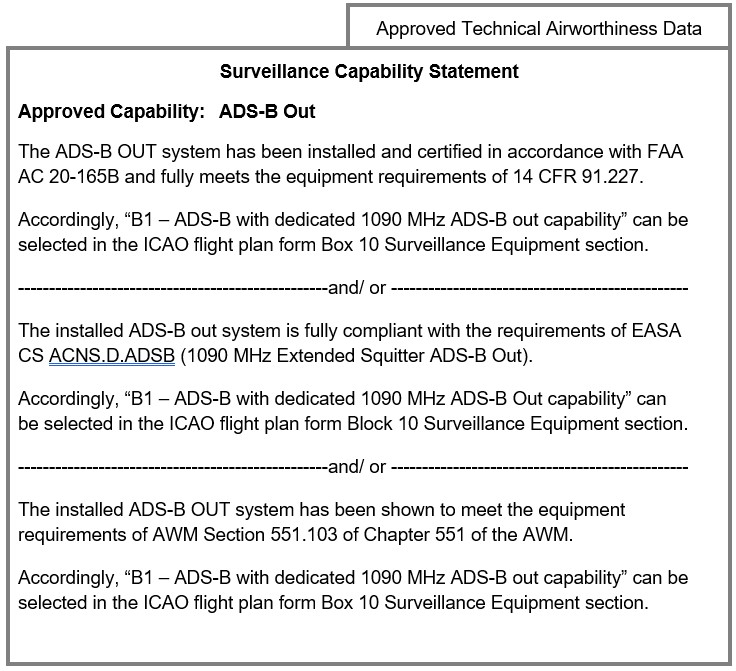Annex H: Surveillance Capability Statements (Step 7b)
1. General
1.1 This annex provides guidance on the development of the Surveillance Capability Statements to be inserted into the FM and/or AOI, as required in Step 7(b) of the Surveillance System Design Certification Process (paragraph 4.2.2.g.(2) of the advisory).
2. Airworthiness Requirements
2.1 The following documents, among others, have a requirement for a capability statement:
- FAA AC 20-165B (advisory reference 3.2.2.k) – Paragraph 2.2 – Aircraft Flight Manual:
“Include ADS-B OUT operating limitations, normal operating procedures, and a system description in the Airplane Flight Manual (AFM), Rotorcraft Flight Manual (RFM), AFM Supplement (AFMS), or RFM Supplement (RFMS). The flight manual must also state that the installation meets the requirements of § 91.227. This can be accomplished by adding the following statement to the General or Normal Procedures section of the flight manual:
The installed ADS-B OUT system has been shown to meet the equipment requirements of 14 CFR 91.227”.
- CS-ACNS Issue 4 (advisory reference 3.2.2.g), Subpart D, Section 4, Appendix G – Example of Flight Manual Supplement for ADS-B Out,
“The installed ADS-B Out system is fully compliant with the requirements of CS ACNS.D.ADSB (1090 MHz Extended Squitter ADS-B Out).”
- TCCA AC 500-029 Issue 2 (advisory reference 3.2.2.o) – Paragraph 4.2 Aircraft Flight Manual:
(1) General or Normal Procedures - Include ADS-B OUT operating limitations, normal operating procedures, and a system description in the Aeroplane Flight Manual (AFM), Rotorcraft Flight Manual (RFM), AFM Supplement (AFMS), or RFM Supplement (RFMS), as applicable. The flight manual must also state that the installation meets the requirements of AWM Section 551.103 of Chapter 551 of the AWM. This can be accomplished by adding the following statement to the General or Normal Procedures section of the flight manual:
“The installed ADS-B OUT system has been shown to meet the equipment requirements of AWM Section 551.103 of Chapter 551 of the AWM.”
2.2 As described in Step 7b of the Surveillance System Design Certification Process, the TAA requires that Surveillance Capability Statements be developed, approved and inserted into in the FM/AOI. The capability statements provide the aircrew with a concise summary of the aircraft’s approved surveillance system capabilities and limitations, and are meant to be used by them in the preparation of flight plans and ATC clearance requests. The surveillance system capability statements may refer to the system description and operating procedures contained in the FM/AOI.
2.3 Once the design assessment (Step 4) has been completed, the Surveillance Capability Statements should be drafted and made available to the Finding Authorities (FAs), to provide them with a summary of the proposed capabilities and limitations arising from the assessment. In their Technical Notes, the FAs will be required to make a recommendation to the TAA regarding the approval of the wording in the capability statements.
2.4 The Surveillance Capability Statements will be approved as part of the TAC approval process. Once the capability statement has been approved by the TAA, the Weapon System Management organization is responsible for inserting the statements into the FM/AOI.
2.5 The format of the capability statements should be consistent with the format and structure of the existing FM/AOI. Subsequent changes to the statements are subject to the Technical Airworthiness Data (TAWD) change approval process described in the TAM (regulatory reference 3.2.1.a).
3. Surveillance Capability Statement Example
3.1 Figure H-1 provides an example of a surveillance capability statement to illustrate the type of information that needs to be included in the FM/AOI, following the approval of a design change supporting ADS-B Out Capabilities.
3.2 The capability statement should identify the criteria against which the system was evaluated and clearly indicate that the system is compliant with the chosen criteria.
3.3 The capability statement should also identify the ICAO Block 10 flight plan code (Surveillance Equipment Section) in either a tabular format, or included with the capability statement (as shown in Figure H-1). For example, “A certified ADS-B with dedicated 1090 MHz ADS-B Out capability can select B1 in the Surveillance Equipment section of Block 10 on the ICAO Flight Plan form".
Note: For information on possible ICAO Block 10 capability codes, refer to ICAO Doc 4444, Procedures for Air Navigation Services, Air Traffic Management, Appendix 2.
